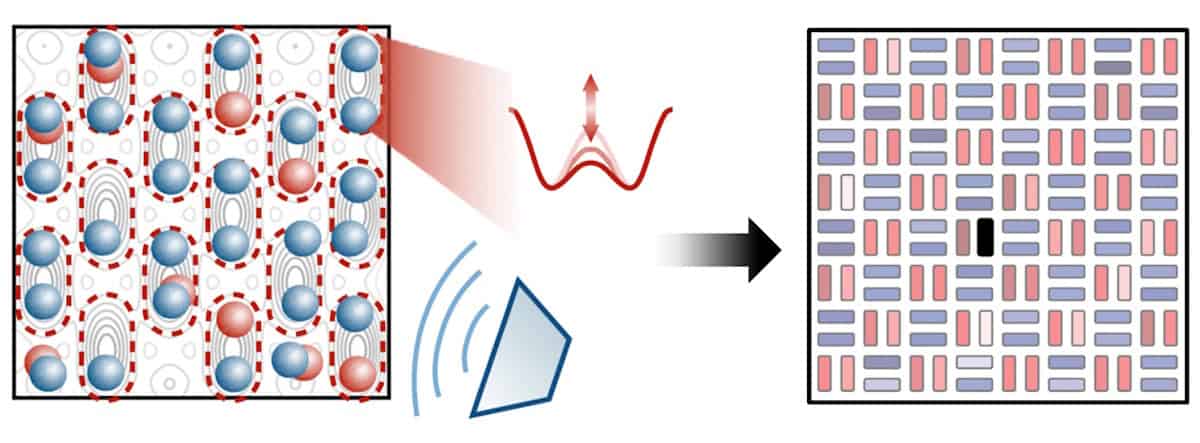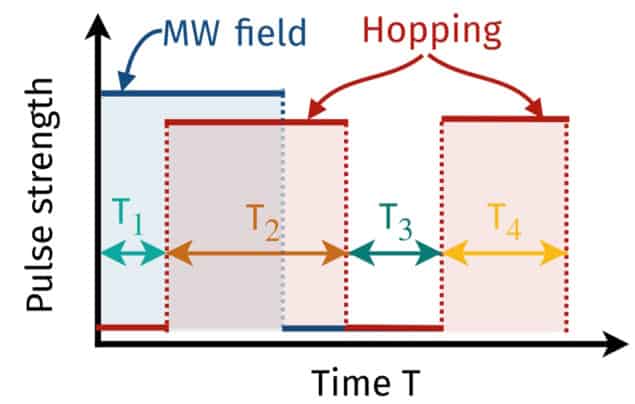These Vampire Deer Have Three-Inch Fangs Instead of Antlers to Fend Off Rivals







Improving the efficiency of solar cells will likely be one of the key approaches to achieving net zero emissions in many parts of the world. Many types of solar cells will be required, with some of the better performances and efficiencies expected to come from multi-junction solar cells. Multi-junction solar cells comprise a vertical stack of semiconductor materials with distinct bandgaps, with each layer converting a different part of the solar spectrum to maximize conversion of the Sun’s energy to electricity.
When there are no constraints on the choice of materials, triple-junction solar cells can outperform double-junction and single-junction solar cells, with a power conversion efficiency (PCE) of up to 51% theoretically possible. But material constraints – due to fabrication complexity, cost or other technical challenges – mean that many such devices still perform far from the theoretical limits.
Perovskites are one of the most promising materials in the solar cell world today, but fabricating practical triple-junction solar cells beyond 1 cm2 in area has remained a challenge. A research team from Australia, China, Germany and Slovenia set out to change this, recently publishing a paper in Nature Nanotechnology describing the largest and most efficient triple-junction perovskite–perovskite–silicon tandem solar cell to date.
When asked why this device architecture was chosen, Anita Ho-Baillie, one of the lead authors from The University of Sydney, states: “I am interested in triple-junction cells because of the larger headroom for efficiency gains”.
Solar cells formed from metal halide perovskites have potential to be commercially viable, due to their cost-effectiveness, efficiency, ease of fabrication and their ability to be paired with silicon in multi-junction devices. The ease of fabrication means that the junctions can be directly fabricated on top of each other through monolithic integration – which leads to only two terminal connections, instead of four or six. However, these junctions can still contain surface defects.
To enhance the performance and resilience of their triple-junction cell (top and middle perovskite junctions on a bottom silicon cell), the researchers optimized the chemistry of the perovskite material and the cell design. They addressed surface defects in the top perovskite junction by replacing traditional lithium fluoride materials with piperazine-1,4-diium chloride (PDCl). They also replaced methylammonium – which is commonly used in perovskite cells – with rubidium. “The rubidium incorporation in the bulk and the PDCl surface treatment improved the light stability of the cell,” explains Ho-Baillie.
To connect the two perovskite junctions, the team used gold nanoparticles on tin oxide. Because the gold was in a nanoparticle form, the junctions could be engineered to maximize the flow of electric charge and light absorption by the solar cell.
“Another interesting aspect of the study is the visualization of the gold nanoparticles [using transmission electron microscopy] and the critical point when they become a semi-continuous film, which is detrimental to the multi-junction cell performance due to its parasitic absorption,” says Ho-Baillie. “The optimization for achieving minimal particle coverage while achieving sufficient ohmic contact for vertical carrier flow are useful insights”.
Using these design strategies, Ho-Baillie and colleagues developed a 16 cm2 triple-junction cell that achieved an independently certified steady-state PCE of 23.3% – the highest reported for a large-area device. While triple-junction perovskite solar cells have exhibited higher PCEs – with all-perovskite triple-junction cells reaching 28.7% and perovskite–perovskite–silicon devices reaching 27.1% – these were all achieved on a 1 cm2 cell, not a large-area cell.
In this study, the researchers also developed a 1 cm2 cell that was close to the best, with a PCE of 27.06%, but it is the large-area cell that’s the record breaker. The 1 cm2 cell also passed the International Electrotechnical Commission’s (IEC) 61215 thermal cycling test, which exposes the cell to 200 cycles under extreme temperature swings, ranging from –40 to 85°C. During this test, the 1 cm2 cell retained 95% of its initial efficiency after 407 h of continuous operation.
The combination of the successful thermal cycling test combined with the high efficiencies on a larger cell shows that there could be potential for this triple-junction architecture in real-world settings in the near future, even though they are still far away from their theoretical limits.
The post Large-area triple-junction perovskite solar cell achieves record efficiency appeared first on Physics World.

In recent years, a popular slogan in the space industry has been, “We are entering the Golden Age of space exploration.” Indeed, we have witnessed unprecedented advancements in launch vehicles, the initial development of private space stations, and all other forms of space-related capabilities. This vision was strengthened even more during the inaugural address earlier […]
The post Let’s not allow the ‘Golden Age’ of space exploration to turn into fool’s gold appeared first on SpaceNews.

ESA has provided more details about the multi-pronged security program it is seeking more than one billion euros for at its upcoming ministerial conference.
The post ESA outlines plans for space security program appeared first on SpaceNews.
It’s rare to come across someone who’s been responsible for enabling a seismic shift in society that has affected almost everyone and everything. Tim Berners-Lee, who invented the World Wide Web, is one such person. His new memoir This is for Everyone unfolds the history and development of the Web and, in places, of the man himself.
Berners-Lee was born in London in 1955 to parents, originally from Birmingham, who met while working on the Ferranti Mark 1 computer and knew Alan Turing. Theirs was a creative, intellectual and slightly chaotic household. His mother could maintain a motorbike with fence wire and pliers, and was a crusader for equal rights in the workplace. His father – brilliant and absent minded – taught Berners-Lee about computers and queuing theory. A childhood of camping and model trains, it was, in Berners-Lee’s view, idyllic.
Berners-Lee had the good fortune to be supported by a series of teachers and managers who recognized his potential and unique way of working. He studied physics at the University of Oxford (his tutor “going with the flow” of Berners-Lee’s unconventional notation and ability to approach problems from oblique angles) and built his own computer. After graduating, he married and, following a couple of jobs, took a six-month placement at the CERN particle-physics lab in Geneva in 1985.
This placement set “a seed that sprouted into a tool that shook up the world”. Berners-Lee saw how difficult it was to share information stored in different languages in incompatible computer systems and how, in contrast, information flowed easily when researchers met over coffee, connected semi-randomly and talked. While at CERN, he therefore wrote a rough prototype for a program to link information in a type of web rather than a structured hierarchy.
Back at CERN, Tim Berners-Lee developed his vision of a “universal portal” to information.
The placement ended and the program was ignored, but four years later Berners-Lee was back at CERN. Now divorced and soon to remarry, he developed his vision of a “universal portal” to information. It proved to be the perfect time. All the tools necessary to achieve the Web – the Internet, address labelling of computers, network cables, data protocols, the hypertext language that allowed cross-referencing of text and links on the same computer – had already been developed by others.
Berners-Lee saw the need for a user-friendly interface, using hypertext that could link to information on other computers across the world. His excitement was “uncontainable”, and according to his line manager “few of us if any could understand what he was talking about”. But Berners-Lee’s managers supported him and freed his time away from his actual job to become the world’s first web developer.
Having a vision was one thing, but getting others to share it was another. People at CERN only really started to use the Web properly once the lab’s internal phone book was made available on it. As a student at the time, I can confirm that it was much, much easier to use the Web than log on to CERN’s clunky IBM mainframe, where phone numbers had previously been stored.
Wider adoption relied on a set of volunteer developers, working with open-source software, to make browsers and platforms that were attractive and easy to use. CERN agreed to donate the intellectual property for web software to the public domain, which helped. But the path to today’s Web was not smooth: standards risked diverging and companies wanted to build applications that hindered information sharing.
Feeling the “the Web was outgrowing my institution” and “would be a distraction” to a lab whose core mission was physics, Berners-Lee moved to the Massachusetts Institute of Technology in 1994. There he founded the World Wide Web Consortium (W3C) to ensure consistent, accessible standards were followed by everyone as the Web developed into a global enterprise. The progression sounds straightforward although earlier accounts, such as James Gillies and Robert Caillau’s 2000 book How the Web Was Born, imply some rivalry between institutions that is glossed over here.
Initially inclined to advise people to share good things and not search for bad things, Berners-Lee had reckoned without the insidious power of “manipulative and coercive” algorithms on social networks
The rest is history, but not quite the history that Berners-Lee had in mind. By 1995 big business had discovered the possibilities of the Web to maximize influence and profit. Initially inclined to advise people to share good things and not search for bad things, Berners-Lee had reckoned without the insidious power of “manipulative and coercive” algorithms on social networks. Collaborative sites like Wikipedia are closer to his vision of an ideal Web; an emergent good arising from individual empowerment. The flip side of human nature seems to come as a surprise.
The rest of the book brings us up to date with Berners-Lee’s concerns (data, privacy, misuse of AI, toxic online culture), his hopes (the good use of AI), a third marriage and his move into a data-handling business. There are some big awards and an impressive amount of name dropping; he is excited by Order of Merit lunches with the Queen and by sitting next to Paul McCartney’s family at the opening ceremony to the London Olympics in 2012. A flick through the index reveals names ranging from Al Gore and Bono to Lucien Freud. These are not your average computing technology circles.
There are brief character studies to illustrate some of the main players, but don’t expect much insight into their lives. This goes for Berners-Lee too, who doesn’t step back to particularly reflect on those around him, or indeed his own motives beyond that vision of a Web for all enabling the best of humankind. He is firmly future focused.
Still, there is no-one more qualified to describe what the Web was intended for, its core philosophy, and what caused it to develop to where it is today. You’ll enjoy the book whether you want an insight into the inner workings that make your web browsing possible, relive old and forgotten browser names, or see how big tech wants to monetize and monopolize your online time. It is an easy read from an important voice.
The book ends with a passionate statement for what the future could be, with businesses and individuals working together to switch the Web from “the attention economy to the intention economy”. It’s a future where users are no longer distracted by social media and manipulated by attention-grabbing algorithms; instead, computers and services do what users want them to do, with the information that users want them to have.
Berners-Lee is still optimistic, still an incurable idealist, still driven by vision. And perhaps still a little naïve too in believing that everyone’s values will align this time.
The post Tim Berners-Lee: why the inventor of the Web is ‘optimistic, idealistic and perhaps a little naïve’ appeared first on Physics World.

Understanding the mechanism of high-temperature superconductivity could unlock powerful technologies, from efficient energy transmission to medical imaging, supercomputing and more. Researchers at Harvard University and the Massachusetts Institute of Technology have designed a new protocol to study a candidate model for high-temperature superconductivity (HTS), described in Physical Review Letters.
The model, known as the Fermi-Hubbard model, is believed to capture the essential physics of cuprate high-temperature superconductors, materials composed of copper and oxygen. The model describes fermions, such as electrons, moving on a lattice. The fermions experience two competing effects: tunnelling and on-site interaction. Imagine students in a classroom: they may expend energy to switch seats (tunnelling), avoid a crowded desk (repulsive on-site interaction) or share desks with friends (attractive on-site interaction). Such behaviour mirrors that of electrons moving between lattice sites.
Daniel Mark, first author of the study, notes that: “After nearly four decades of research, there are many detailed numerical studies and theoretical models on how superconductivity can emerge from the Fermi-Hubbard model, but there is no clear consensus [on exactly how it emerges].”
A precursor to understanding the underlying mechanism is testing whether the Fermi-Hubbard model gives rise to an important signature of cuprate HTS: d-wave pairing. This is a special type of electron pairing where the strength and sign of the pairing depend on the direction of electron motion. It contrasts with conventional low-temperature superconductors that exhibit s-wave pairing, in which the pairing strength is uniform in all directions.
Although physicists have developed robust methods for simulating the Fermi-Hubbard model with ultracold atoms, measuring d-wave pairing has been notoriously difficult. The new protocol aims to change that.
A key ingredient in the protocol is the team’s use of “repulsive-to-attractive mapping”. The physics of HTS is often described by the repulsive Fermi-Hubbard model, in which electrons pay an energetic penalty for occupying the same lattice site, like disagreeing students sharing a desk. In this model, detecting d-wave pairing requires fermions to maintain a fragile quantum state as they move over large distances, which necessitates carefully fine-tuned experimental parameters.
To make the measurement more robust to experimental imperfection, the authors use a clever mathematical trick: they map from the repulsive model to the attractive one. In the attractive model, electrons receive an energetic benefit from being close together, like two friends in a classroom. The mapping is achieved by a particle–hole transformation, wherein spin-down electrons are reinterpreted as holes and vice versa. After mapping, the d-wave pairing signal becomes an observable that conserves local fermion number, thereby circumventing the challenge of long-range motion.

In its initial form, the d-wave pairing signal is difficult to measure. Drawing inspiration from digital quantum gates, the researchers divide their complex system into subsystems composed of pairs of lattice sites or dimers. Then, they apply a pulse sequence to make the observable measurable by simply counting fermions – a standard technique in the lab.
The pulse sequence begins with a global microwave pulse to manipulate the spin of the fermions, followed by a series of “hopping” and “idling” steps. The hopping step involves lowering the barrier between lattice sites, thereby increasing tunnelling. The idling step involves raising the barrier, allowing the system to evolve without tunnelling. Every step is carefully timed to reveal the d-wave pairing information at the end of the sequence.
The researchers report that their protocol is sample-efficient, experimentally viable, and generalizable to other observables that conserve local fermion number and act on dimers.
This work adds to a growing field that combines components of analogue quantum systems with digital gates to deeply study complex quantum phenomena. “All the experimental ingredients in our protocol have been demonstrated in existing experiments, and we are in discussion with several groups on possible use cases,” Mark tells Physics World.
The post New protocol makes an elusive superconducting signature measurable appeared first on Physics World.
Exchange-coupled interfaces offer a powerful route to stabilising and enhancing ferromagnetic properties in two-dimensional materials, such as transition metal chalcogenides. These materials exhibit strong correlations among charge, spin, orbital, and lattice degrees of freedom, making them an exciting area for emergent quantum phenomena.
Cr₂Te₃’s crystal structure naturally forms layers that behave like two-dimensional sheets of magnetic material. Each layer has magnetic ordering (ferromagnetism), but the layers are not tightly bonded in the third dimension and are considered “quasi-2D.” These layers are useful for interface engineering. Using a vacuum-based technique for atomically precise thin-film growth, known as molecular beam epitaxy, the researchers demonstrate wafer-scale synthesis of Cr₂Te₃ down to monolayer thickness on insulating substrates. Remarkably, robust ferromagnetism persists even at the monolayer limit, a critical milestone for 2D magnetism.
When Cr₂Te₃ is proximitized (an effect that occurs when one material is placed in close physical contact with another so that its properties are influenced by the neighbouring material) to a topological insulator, specifically (Bi,Sb)₂Te₃, the Curie temperature, the threshold between ferromagnetic and paramagnetic phases, increases from ~100 K to ~120 K. This enhancement is experimentally confirmed via polarized neutron reflectometry, which reveals a substantial boost in magnetization at the interface.
Theoretical modelling attributes this magnetic enhancement to the Bloembergen–Rowland interaction which is a long-range exchange mechanism mediated by virtual intraband transitions. Crucially, this interaction is facilitated by the topological insulator’s topologically protected surface states, which are spin-polarized and robust against disorder. These states enable long-distance magnetic coupling across the interface, suggesting a universal mechanism for Curie temperature enhancement in topological insulator-coupled magnetic heterostructures.
This work not only demonstrates a method for stabilizing 2D ferromagnetism but also opens the door to topological electronics, where magnetism and topology are co-engineered at the interface. Such systems could enable novel quantum hybrid devices, including spintronic components, topological transistors, and platforms for realizing exotic quasiparticles like Majorana fermions.
Enhanced ferromagnetism in monolayer Cr2Te3 via topological insulator coupling
Yunbo Ou et al 2025 Rep. Prog. Phys. 88 060501
Interacting topological insulators: a review by Stephan Rachel (2018)
The post Interface engineered ferromagnetism appeared first on Physics World.
First proposed in 1964, the Higgs boson plays a key role in explaining why many elementary particles of the Standard Model have a rest mass. Many decades later the Higgs boson was observed in 2012 by the ATLAS and CMS collaborations at the Large Hadron Collider (LHC), confirming the decades old prediction.
This discovery made headline news at the time and, since then, the two collaborations have been performing a series of measurements to establish the fundamental nature of the Higgs boson field and of the quantum vacuum. Researchers certainly haven’t stopped working on the Higgs though. In subsequent years, a series of measurements have been performed to establish the fundamental nature of the new particle.
One key measurement comes from studying a process known as off-shell Higgs boson production. This is the creation of Higgs bosons with a mass significantly higher than their typical on-shell mass of 125 GeV. This phenomenon occurs due to quantum mechanics, which allows particles to temporarily fluctuate in mass.
This kind of production is harder to detect but can reveal deeper insights into the Higgs boson’s properties, especially its total width, which relates to how long it exists before decaying. This in turn, allows us to test key predictions made by the Standard Model of particle physics.
Previous observations of this process had been severely limited in their sensitivity. In order to improve on this, the ATLAS collaboration had to introduce a completely new way of interpreting their data (read here for more details).
They were able to provide evidence for off-shell Higgs boson production with a significance of 2.5𝜎 (corresponding to a 99.38% likelihood), using events with four electrons or muons, compared to a significance of 0.8𝜎 using traditional methods in the same channel.
The results mark an important step forward in understanding the Higgs boson as well as other high-energy particle physics phenomena.
The ATLAS Collaboration, 2025 Rep. Prog. Phys. 88 057803
The post Probing the fundamental nature of the Higgs Boson appeared first on Physics World.

MOUNTAIN VIEW, California – Satellite-servicing businesses are finally getting off the ground thanks in part to technological innovation and the example set by prime contractor Northrop Grumman. “There is no shame in saying that we are riding on Northrop’s coattails,” said Luis Vidal, Starfish Space commercial geostationary business development director. “Northrop broke the suspension of […]
The post Rising demand and falling costs clear path for satellite servicing appeared first on SpaceNews.


Berkowitz says one of his priorities as assistant secretary of defense for space policy would be to ‘sustain America’s position as the world’s leader in space activities’
The post Pentagon nominee: Closer Space Force-NRO integration ‘worth considering’ appeared first on SpaceNews.

Preparations for NASA’s Artemis 2 launch could soon grind to a halt if the nearly month-long government shutdown continues, one industry executive warned.
The post Shutdown could soon slow preparations for Artemis 2 appeared first on SpaceNews.




